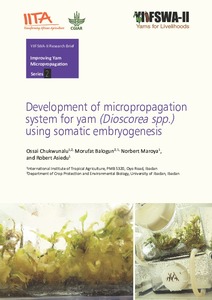| dc.contributor.author | Ossai, C. |
| dc.contributor.author | Balogun, M. |
| dc.contributor.author | Maroya, N. |
| dc.contributor.author | Asiedu, Robert |
| dc.date.accessioned | 2019-12-04T11:31:32Z |
| dc.date.available | 2019-12-04T11:31:32Z |
| dc.date.issued | 2018 |
| dc.identifier.citation | Ossai, C., Balogun, M., Maroya, N. & Asiedu, R. (2018). Development of micropropagation system for yam (Dioscorea spp.) using somatic embryogenesis. Ibadan, Nigeria: IITA, (8p). |
| dc.identifier.isbn | 978-978-131-356-1 |
| dc.identifier.uri | https://hdl.handle.net/20.500.12478/5521 |
| dc.description.abstract | Inadequate availability of disease-free planting materials remains a major constraint to yam production.
The tissue culture technique has been used to regenerate disease-free plantlets from pre-formed, heattreated
meristems followed by micropropagation. This procedure, however, has a low multiplication
ratio with an average of 1: 4 every eight weeks. Embryo production from somatic cells (somatic
embryogenesis, SE) is a system in which each somatic cell can regenerate a complete plantlet. However,
previous reports show low SE induction frequencies and significant variations in success rates among
different genotypes while hardly any report exist for improved varieties that farmers desire, especially
in Nigeria. Studies were carried out to evaluate the effects of different plant growth regulators (PGRs)
on induction of somatic embryogenesis of the following genotypes: one improved Dioscorea alata (TDa
291) and three improved (TDr 95/19177, TDr 89/2665, TDr 95/18544) and one landrace (Obioturugo)
of Dioscorea rotundata. Leaf, stem, and axillary bud explants were cultured in MS basal medium
containing fifteen treatment combinations of 2,4-Dichlorophenoxyacetic acid (2,4-D), Naphthaleneacetic
acid (NAA), Benzylaminopurine (BAP), Picloram, and Uniconazole-P (UP). The genotype TDr 95/19177
was tested for SE in Temorary Immersion Bioreactor System (TIBS). The incidence of induction of
callus formation and plantlet regeneration from the three explants were recorded. Embryogenic callus
induction was highest (87%) from axillary buds cultured on modified MS + 2 mg/l of 2,4-D + 1 mg/l of
NAA while 1 mg/l of BAP + 9. 9 mg/l of UP had the highest percentage plantlet regeneration of 50%
in TDr 95/18544 and an average of 37% across genotypes at a mean of 5 plantlets per explant. The
genotype TDr 95/19177 was successfully regenerated via indirect somatic embryogenesis in the SETIS
Type Temporary Immersion Bioreactor System. |
| dc.description.sponsorship | Bill & Melinda Gates Foundation |
| dc.format.extent | 8 p. |
| dc.language.iso | en |
| dc.publisher | International Institute of Tropical Agriculture |
| dc.relation.ispartofseries | YIIFSWA Research Brief: Improving Yam Micropropagation Series 2; |
| dc.rights | CC-BY-4.0 |
| dc.subject | Yams |
| dc.subject | Food Security |
| dc.subject | Food Production |
| dc.subject | West Africa |
| dc.subject | Nigeria |
| dc.subject | Somatic Embryos |
| dc.subject | Callus |
| dc.subject | Bioreactors |
| dc.title | Development of micropropagation system for yam (Dioscorea spp.) using somatic embryogenesis |
| dc.type | Book |
| dc.description.version | Peer Review |
| cg.contributor.crp | Roots, Tubers and Bananas |
| cg.contributor.affiliation | International Institute of Tropical Agriculture |
| cg.contributor.affiliation | University of Ibadan |
| cg.coverage.region | Africa |
| cg.coverage.region | West Africa |
| cg.coverage.country | Nigeria |
| cg.creator.identifier | Morufat Balogun: 0000-0001-8770-5529 |
| cg.creator.identifier | Norbert Maroya: 0000-0002-7079-4729 |
| cg.creator.identifier | Robert Asiedu: 0000-0001-8943-2376 |
| cg.researchtheme | BIOTECH & PLANT BREEDING |
| cg.authorship.types | CGIAR and developing country institute |
| cg.iitasubject | Food Science |
| cg.iitasubject | Food Security |
| cg.iitasubject | Plant Breeding |
| cg.iitasubject | Yam |
| cg.howpublished | Formally Published |
| cg.publicationplace | Ibadan, Nigeria |
| cg.accessibilitystatus | Open Access |
| local.dspaceid | 104019 |
| cg.targetaudience | Scientists |

